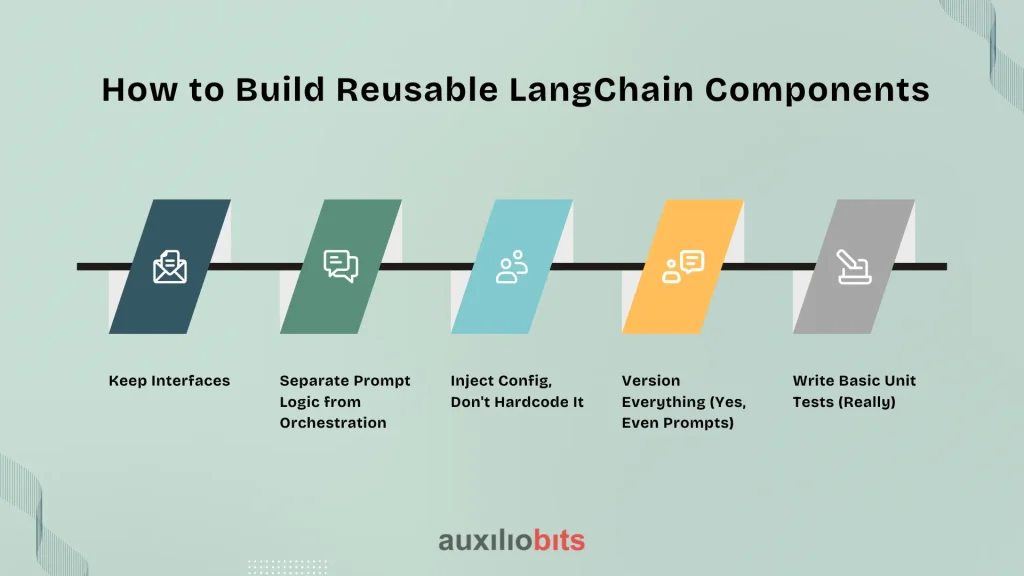
Key Takeaways
- Reusability is not a nice-to-have—it’s essential infrastructure
In large organizations, unshared logic leads to duplicated efforts and brittle architectures. Shared components drive efficiency and maintainability. - Focus on practical reusability, not theoretical flexibility
The most valuable reused parts—like prompt templates or chain wrappers—are small, boring, and well-contained, not overly generic or clever. - Not everything should be reused
Domain-specific, demo-grade, or short-lived logic isn’t worth modularizing. Reusability adds overhead, so know when to build fast and discard. - Reusable components need clean interfaces and external configs
Good components accept inputs, return predictable outputs, and rely on injected parameters—not hardcoded values or deep abstractions. - Governance makes or breaks reuse at scale
Without clear ownership, versioning, and discoverability, reusable LangChain components can quickly become unusable or counterproductive.
There’s a familiar pattern in most enterprise teams dabbling with LangChain. A developer builds a chatbot. Another team rolls out a document summarizer. Marketing gets excited about AI-generated content. And just like that, three silos are solving similar problems—differently.
Nobody sets out to duplicate effort, of course. But in large organizations, that’s the default unless someone takes a step back and says, “Wait, haven’t we solved this already?”
This is where reusability enters the picture—not as a buzzword, but as a lifeline. It’s the difference between building ten brittle tools and building three solid ones that flex just enough to serve everyone.
Also read: Agentic AI for Unstructured Data: LangChain and WhisperAI in Action
Why Reusability Isn’t Just “Good Practice”
The temptation is to treat “reusable components” like a style choice—like tabs vs. spaces. In reality, it’s infrastructure. If your LangChain apps are meant to scale across departments, projects, and functions, then not sharing core logic isn’t inefficient—it’s unsustainable.
But—and this is a big but—reuse doesn’t mean overengineering. A reusable component doesn’t have to be generic. It just has to be portable enough, stable enough, and well-contained enough that someone else can adopt it without tearing it apart first.
Also, reusability doesn’t mean universal applicability. Sometimes you build a thing that only makes sense in procurement. Fine. Not everything has to scale org-wide. But when three different teams independently build their own CustomerDataQueryTool, maybe it’s time to centralize.
What Gets Reused (and What Fails the Test)
You’ll hear advice like “modularize everything” or “write reusable chains from the start.” It’s terrible advice in practice. Because not everything deserves to be reused, and trying to make every function generic is a shortcut to paralysis.
In real-world enterprise LangChain work, here’s what ends up getting reused:
Commonly Reused
- Prompt templates: Especially when templated for tone, audience, region, or content type. Think: {industry}, {persona}, {language}—the usual suspects.
- Structured output parsers: JSON, YAML, and Pydantic-based outputs—whatever helps downstream systems stop panicking.
- Custom agent tools: Internal API callers, ticket raisers, and CRM updaters. Once a team wraps these as LangChain-compatible tools, others will adopt them fast (assuming they’re documented).
- Retry + logging logic: Middleware that handles exceptions, logs calls, retries failed invocations, or stores intermediate steps for debugging. It’s unglamorous but always in demand.
- Chain wrappers: Stuff like “auto-summarize, then translate, push to SharePoint.” These little pipelines become building blocks.
Rarely Worth Reusing
- Domain-specific prompts filled with internal jargon.
- Single-purpose chains built around one-off CSVs or XML formats.
- Anything hastily built for a pitch deck or demo—it’ll break the minute someone changes a parameter.
You’ll notice that what gets reused isn’t necessarily the most “complex” stuff—it’s the boring, repeatable plumbing that nobody wants to rebuild.
Real Example: The Redundant Tool That Triggered a Rewrite
A client in logistics had three separate LangChain workflows: one for vendor email classification, one for support ticket triage, and one for customs documentation. Different teams, different LLMs, different inputs. But all three:
- Parsed semi-structured text
- Extracted metadata (like sender, location, document type)
- Routed data to downstream systems
Each one had its fragile logic for parsing outputs and calling the API. Each team grumbled about maintenance.
Eventually, someone noticed and said, “Can we just wrap this logic once and reuse it?”
So they did. They built a shared TextClassifier component that handled prompt templating, LLM invocation, schema validation, and output normalization. Teams only had to pass in config files.
The component wasn’t perfect. But it removed 400 lines of repeated logic, cut maintenance time by half, and became the default for any classification-style task org-wide.
How to Build Reusable LangChain Components

1. Keep Interfaces Thin
Don’t wrap every LangChain call in layers of abstraction. Just isolate the decision-making part. A reusable prompt template, for instance, should take a dict of inputs and return a string—not manage its own memory or API client.
2. Separate Prompt Logic from Orchestration
Keep your prompt templates and tools modular. Let chains be dumb glue code. You want your SummarizeDocument component to be usable with or without a parent agent or memory system.
3. Inject Config, Don’t Hardcode It
Model names, temperature, system messages—these shouldn’t live in the middle of a function. Pass them in. Even better, make them part of a YAML or TOML config that other teams can tweak without touching the code.
4. Version Everything (Yes, Even Prompts)
Prompt drift is real. You change a few words, and suddenly the LLM behaves completely differently. Track versions. Store them in Git. Name them descriptively.
5. Write Basic Unit Tests (Really)
No, you can’t fully unit test an LLM. But you can check that a tool accepts inputs and returns a sane structure. A few basic asserts can catch 80% of stupid bugs before someone else wastes their afternoon debugging your component.
Governance: The Part Everyone Forgets Until It’s Too Late
LangChain encourages experimentation. That’s great for prototypes. Not so great for shared infrastructure.
If you’re planning to make anything reusable beyond your team, you’ll need some (lightweight) governance.
Consider:
- Who maintains shared components? If nobody owns it, it will rot.
- How are breaking changes managed? Even a changed default model can quietly break downstream results.
- How do teams discover reusable components? If you’ve got a registry, great. If not, even a wiki or shared Slack channel is a start.
And if you’re in a regulated industry? You need to track who changed what, when, and why. Reusability without observability is just a fancier mess.
When to Avoid Reusability Altogether
Let’s not pretend everything needs to be reusable.
Sometimes, the right move is to write a fast, brittle, single-purpose thing and throw it away after a week. No shame in that. Especially for:
- Pilot projects
- Temporary integrations
- Model experimentation (e.g., comparing Claude vs GPT vs Mistral)
Reusability has a cost. It demands design, structure, and documentation. If you’re not going to use something twice, it’s probably not worth making it generic.
The trick is knowing when to stop polishing and just ship it.
Final Thoughts
Reusable LangChain components aren’t about elegance. They’re about velocity. You’re trying to help ten teams avoid writing the same prompt parser with slightly different spacing. They’re also not about theoretical flexibility. A prompt template that handles 200 cases is usually worse than three that each handle 10 well. The most valuable components I’ve seen reused weren’t the “cleverest”—they were the ones with the cleanest inputs, the clearest contracts, and the fewest surprises. Build the boring stuff first. Wrap the fragile logic. Document just enough that the next team doesn’t face any hassle.








